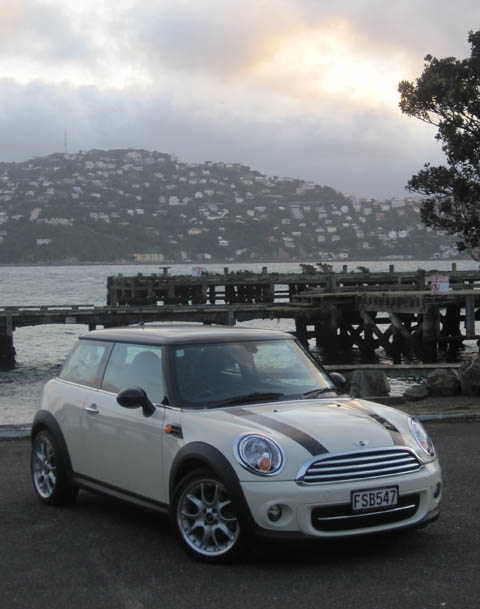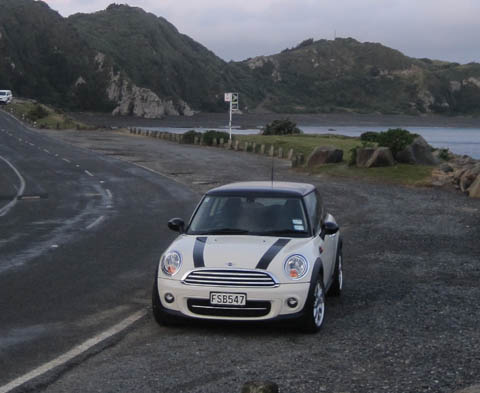|

I HAVE no real problem with BMW
making the claim that the Mini Cooper D is the country’s most economical
car, but the absence of a trip computer, I thought, was a bit cheeky.
Of all the Minis that had made their way to Lucire, this
feature was always installed, and I delighted in returning test
cars with better mpg ratings than what the previous journalist had
managed.
In these times, driving in an economical fashion is
no longer an art, it’s a necessity.
But in BMW’s defence,
maybe omitting the feature made sense. While the company claims
the Cooper D does 3·9 l/100 km (a remarkable 72 mpg Imperial) on
a combined cycle, the question is not whether anyone in the press—outside
the dedicated car magazines with their own testing gear—could match
the number, but whether anyone would want to.
The D came didn’t come with the stripped-down looks
that you might get when heading over to Ford for a Fiesta Econetic
or Volkswagen for the Polo for its basic TDI.
It looked like any Mini Cooper did, with stripes, alloy wheels and
that purposeful stance that demanded that the first CD
you ever put in to its audio system be The Italian Job’s
1969 soundtrack.
When the Cooper D looks that good, you want to relive
scenes from the movie, and since ours was white, all we needed were
another two in red and blue.
Everything inside is familiar enough: a comfortable
seating position, the large, central dial harking back to the 1959
original, and, for safety’s sake, a digital read-out within the
rev counter placed directly ahead of the driver. The radio managed
to pick up and remain on our station of choice—the guard-band Groove
FM on 107·7 MHz, one that not
every car manages to stay locked on east of the Mt Vic Tunnel in
Wellington. The design features were just as funky as when we last
tested an R56 Mini hatch—namely the
top-of-the-line John Cooper Works a few years ago—and you did
not feel, despite this being the supposed economy model, that you
were being short-changed. (That would be left to the One D, not
offered in this market.)
It’s all good till you do put that CD
in and turn on the engine. The throaty tune that sings through the
Works, and, to a muted extent, the basic petrol Cooper S, isn’t
there. It is replaced by a sensible BMW
diesel purr, which is little surprise since the Cooper D shares
its heart with the Einser, the 1-series. Sensibly, ours was equipped
with stop–start, which should save even more fuel. The two-litre
lump produces 112 PS (82 kW), which is healthy enough to propel
the D through traffic, and give it a sufficient nudge coming out
of Wellington’s motorway tunnel when the speed limit jumps from
60 to 100 km/h.
However, as much as Quincy Jones played through the
sound system, the strains of ‘Self-Preservation Society’ cheering
Mr Bridger on in The Italian Job, the engine note didn’t
seem to stir the soul.
So is it a dud? No.
In fact, the Cooper D redeems itself arguably better
than the petrol model, and I’m not going to get eco on you in writing
this. So it’s 70 PS down on the regular
Cooper S, but, frankly, you don’t feel 70 PS
lighter with your right foot. In fact, Mini marketing has you expecting
a go-kart with the regular S, and unless you put the gearbox in
sport mode, it’s a sensible city car. The Clubman estate, even more
so. But the D comes to you with the image of an economy car—and
actually surprises as to how well it puts that 112 PS
on to the road.
Where the car really shows its true colours is in its
handling. I took the D over the Rimutaka Hill Road and back, perhaps
the closest Wellingtonians would get to an Italian Job-like
driving experience, with its twisty and often unforgiving turns.
Who needs a Welsh B-road or, for that matter, Abbas–Mustan’s
Players, the remake of the remake of The Italian Job,
with its Wellington City chase scene? This is macho territory: the
road where the human can measure how well connected one is to the
machine.
And here, you forget the engine note. The Cooper D is
so entertaining, so responsive, and so nimble that you feel incredibly
fulfilled driving it. Quincy Jones’s music works once more. I was
so engaged with the experience that this would be my car of choice
if I had to do the trip again.
While I never knew what mileage I managed, it would
certainly be healthier than the Works (7·1 l/100 km, or 39 mpg,
a figure that we never matched, with 32 mpg at the end of our test).
But why the Diesel over a car that entertains more often, from the
moment you turn on the ignition?
The first is the obvious one: money. With fuel prices
heading north constantly, a diesel makes sense, and if BMW’s
claim of 72 mpg is true, then this is an excellent proposition—for
the heart and the wallet.
The second is something you won’t see road testers admit
to: that sometimes, less power is cleverer. It’s a matter of how
well that power gets on to the road.
In my earlier days, testing the Peugeot 205 GTI
1·9 around Mt Victoria, I felt it was twitchy at the limit. Many
cars are. And sometimes, you don’t want the temptation of a car
that reaches those limits quite so easily. Around town, it’s unnecessary.
With Gatsos and congestion, who needs the stress?
Cars like the Works are wonderful if you are purposely
taking it out to a B-road with the intent of opening it up, but
as a day-to-day proposition, you need a car to manage a Jekyll and
Hyde personality. The Works is all Hyde. The Cooper D is, most of
the time, Dr Jekyll—and it’s only on the most entertaining road
that Hyde comes out. That makes sense to me.
So while you won’t be able to perform a gold heist in
Torino—or Wellington, for that matter—doing the getaway is particularly
sweet. •
Jack Yan is publisher of Lucire.

|
 |
Where the car really shows its true colours is
in its handling. I took the D over the Rimutaka Hill Road and back,
perhaps the closest Wellingtonians would get to an Italian Job-like
driving experience, with its twisty and often unforgiving turns.
Who needs a Welsh B-road or, for that matter, Abbas–Mustan’s Players,
the remake of the remake of The Italian Job, with its Wellington
City chase scene?
|

